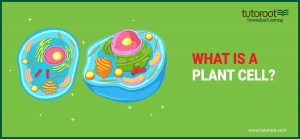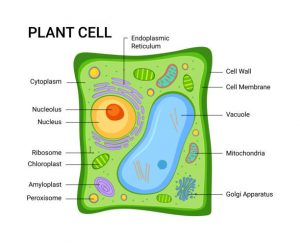Plant Cell – Definition, Diagram, Structure
All the organisms across the planet earth have different types of cells, which act as basic units of life, that provide different attributes to the said living organisms. One such life-giving cell found in plants and trees is called the plant cell. While we try to analyze various aspects related to life, learning about the plant cell, in many ways becomes the basis for most.
Thus, we must give priority to understanding the plant cell and how it works. In this article, we take you through the plant cell and its importance and structure. We also present the diagram of a plant cell that provides a detailed explanation on various aspects, to begin with the structure of the plant cell.
What is a Plant Cell?
A plant cell is defined as a combination of eukaryotic cells that includes a true nucleus as well as multiple specialized structures, which are referred to as organelles. These structures of plant cells perform different functions which in turn help the plant’s growth.

Types of Plant Cell
Plant cells, as explained in general, perform crucial functions that determine and guarantee the existence and survival of any plant, especially in matured plants. Some of the plant cells also handle the logistics of nutrients and water, while many others help in storing food. All these technically help us categorize plant cells based on functions, structures, and other aspects.
Some specialized plant cells are generally parenchyma cells, sclerenchyma cells, collenchyma cells, xylem cells, and phloem cells.
As explained above, plant cells are differentiated into multiple types, based on their functions, and their components, such as,
- Xylem Plant Cell
- Collenchyma Plant Cell
- Parenchyma Plant Cell
- Sclerenchyma Plant Cell
- Phloem Plant Cell.
Classification based on the primary function of the plant cells
The plant cells which are used to transport water, food, and essential minerals from roots to various parts of the plants’ bodies are called Xylem Plant Cells.
Collenchyma Plant Cell
These cells consist of hardening agents, which provide various functions like support, flexibility, mechanical strength, and structure, to various parts in the plants such as stem, leaf veins, petiole, etc.
Parenchyma Plant Cell
One of the most important plant cells, as they play a major role in the production of leaves. More importantly, these cells are thinner and are generally used for various purposes, such as cell metabolism, exchange of gases, organic product storage, and many more.
Sclerenchyma Plant Cell
These cells are quite like the Collenchyma Cells, however, the number of rigid cells or hardening agents in these cells is much more. This is why these cells are commonly observed in roots, and other parts, which support the plants like structures, stems, etc.
Xylem Plant Cell
The cells which are used to transport water, food, and essential minerals from roots to various parts of the plants’ bodies are called Xylem Plant Cells.
Phloem Plant Cell
Another type of transport cells in plants generally transports food particles from leaves to various parts of the plants.
Diagram of Plant Cell

Vector illustration of the Plant cell anatomy structure or plant cell diagram. Infographic with a nucleus, mitochondria, endoplasmic reticulum, Golgi apparatus, cytoplasm, wall membrane. Please view the diagram of the plant cell with extra attention and understand various intrinsic and interesting elements.
As you can see from the above plant cell diagram, the plant cell has many parts or organelles, each of which has unique functions and features that ensure the sustainability of the cell.
Let us now get into the structure of the plant cell and various components in it
Cell Wall
We often begin with showcasing and explaining the cell wall that represents the rigid layer of any plant cell structure and is made up of polysaccharides cellulose, pectin and hemicellulose. The cell wall as the plant cell diagram can illustrate, is located outside the cell membrane.
Cell Membrane
A cell membrane in the plant cell structure refers to a semi-permeable membrane located inside the cell wall, and it is made up of fat and a thin layer of protein. The cell membrane acts as a barrier between toxins, and the cells, however, it assists in transporting food and minerals, in and out of cells. The cell membrane is also referred to as the plasma membrane and is present in every living organism, while the cell wall can only be found in plants, fungi and some bacteria. As explained, if the structural strength and rigidity of a plant body is due to the cell wall, the cell membrane in a plant cell structure is all about protection.
Nucleus
A membrane-bound structure is located inside the eukaryotic cells, whose main function is to store all the hereditary information and DNA that are essential for various processes, such as growth, cell division, and metabolism. Moreover, it consists of two types of components:
- Nucleopore – A membrane that is full of holes referred to as nucleopore, which are used for the transfer of nucleic acids and proteins.
- Nucleolus – This component helps in the manufacture of ribosomes, cell-protein-producing structures, etc.
The nucleus is a Latin expression and means ‘kernel of a nut’. It is technically the storehouse of genetic material and is the most evident organelle in a cell. It is surrounded by cell membranes that differentiate the cytoplasm from the contents.
The typical functions of a nucleus in plant cells can be classified as follows:
- Storing the cell’s hereditary data and regulating and balancing the growth of a cell and its reproduction
- Being an address to various cellular processes besides storing genetic material. It is a place of transcription where various kinds of RNA are created out of DNA, where DNA is duplicated through the process called DNA Replication
- Inside the nucleus, two identical copies of the body or host is the first step in cell division that can be produced. Here, every new cell has its own list of instructions
Thus, the nucleus is busy executing several diverse and crucial cellular processes, from protein synthesis to cell division, from DNA replication to cell growth, to list a few.
Plastids
Plastids are another important part of the plant cell and are membrane-bound organelles that play a major role in the photosynthesis process, storing starch. They are also vital in the synthesis of many molecules. Besides, plastids have their own DNA, and they are differentiated into three types.
- Chloroplast – Plastids that are shaped like a green disc containing DNA, which in turn includes chlorophyll, which acts as the main component in the process of Photosynthesis. These are biconvex in shape, are semi-porous, and are double membraned. They are located within the mesophyll of a plant cell. As explained, they are the points of photosynthesis.
- Leucoplasts – This membrane has nothing to do with the photosynthesis process, and is actively used to store lipids, starch, and protein. Leucoplasts are organelles without pigmentation and are colorless too. They are usually spotted in many non-photosynthetic parts of the plant, such as roots. They are like storage houses to maintain the reserves of starches, proteins, and lipids.
Leucoplasts are categorized into three types:
- Amyloplasts – Amyloplasts store and synthesize starch
- Proteinoplasts – Proteinoplasts help in the storage of proteins needed by plants. These are typically stored in the seeds
- Elaioplasts -Elaioplast store fats and oils for the plant
Chromoplasts
Chromoplasts are colored plastids and are heterogeneous. They are responsible for pigment synthesis and are instrumental in the storage of photosynthetic eukaryotic organisms. The colored pigments in them include those of red, orange, and yellow. They are responsible for ripening fruits and flowers
Plastids – how are they inherited
Many plants are inherited from plastids from a single parent
Golgi Apparatus
The components of plant cells are responsible for distributing the synthesized macromolecules to different parts. The Golgi Apparatus also carry multiple names such as Golgi Body or Golgi Complex. They are primarily named after the scientist who discovered them. The scientist’s name is Camillo Golgi.
The apparatus consists of a series of compartments called cisternae, which are like stacked pouches forming the apparatus.
The Golgi Apparatus play a key role in many cellular functions of the plant cell including synthesizing of complex polysaccharides of the cell wall
Mitochondria
The double-membraned cells are most learned about. Mitochondria are crucial for breaking down carbohydrates and sugar molecules to release energy for the photosynthesis process. This is why these components are generally referred to as the powerhouse of cells.
The expression, ‘mitochondrion’ is derived from the Greek words “mitos” and “chondrion” which means “thread” and “granules-like”, respectively. It was first popularized by the German pathologist, Richard Altmann, in 1890.
The structure of mitochondria consists of outer and inner membranes, besides the matrix. This matrix consists of essential enzymes needed for the Krebs cycle which is the next step in cellular respiration. The matrix also stores the DNA of the mitochondria. Mitochondria is different from other organelles, in terms of having their own DNA and ribosomes that can create their own proteins.
Lysosome
Vacuoles are called Lysosomes, whose primary function is to dispose of foreign bodies, cellular waste, worn-out organelles, etc. This process occurs by enclosing the above-mentioned materials in an enclosed membrane that consists of digestive enzymes.
Ribosomes
Ribosomes are called protein factories of cells, as they comprise RNA and protein, which are actively used for the process of Photosynthesis. Moreover, Ribosomes are said to be the smallest membrane-bound organelles in the cell.
Central Vacuole
The Central Vacuole is a membrane covered by a Tonoplast, that generally consists of cell sap. Besides, the primary function of the Central Vacuole membrane is to sustain turgor pressure on the cell wall.
Functions of Plant Cell
The plant cells perform various important functions in the plants and are like blocks and segments that define the structure. Their most important function is Photosynthesis, through which plants convert carbon dioxide into oxygen. Photosynthesis takes place in the chloroplasts of a plant cell and is the typical process where plant food is prepared by the plant itself. This is done by processing sunlight, carbon dioxide, and water. Energy is produced in the form of ATP.
Besides this, the plant cells also play an active role in transporting various types of components including food, starch, minerals, and nutrients across various parts of the plant.
Conclusion
In the above article, we have talked in detail about Plant Cells, their parts, types of parts in plants, the nucleus in a plant cell, plant cell structure, and many more, by providing detailed descriptions and diagrams of plant cells labeled. And as you know, Biology is a very tough subject, because of the inclusion of a vast number of topics or chapters. So, if you are having any trouble remembering or understanding these topics, it is better for you to join the online interactive classes offered by the Tutoroot platform as they come with expert staff guidance, access to the best educational guides and materials, cost-effective prices, and a lot more.
Frequently Asked Questions
What are the organelles that are found only in plant cells?
Cell wall, plastids, and the large central vacuole
Which is the largest cell organelle present in plant cells?
The nucleus is the largest cell organelle in a plant cell.
What are the different types of plant cells?
Collenchyma, sclerenchyma, parenchyma, xylem and phloem.
Who discovered plant cells?
Back in the year 1665, Scientist Robert Hooke discovered plant cells.
